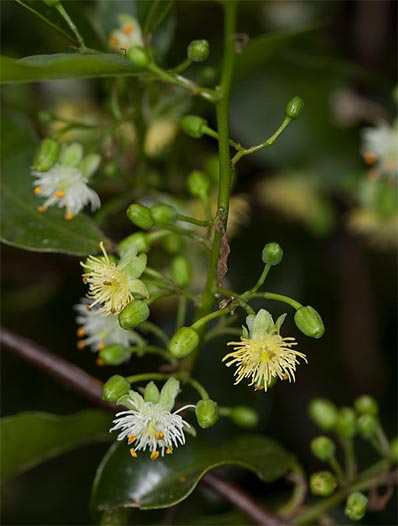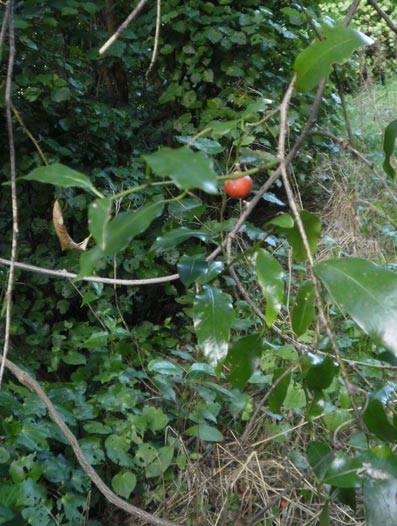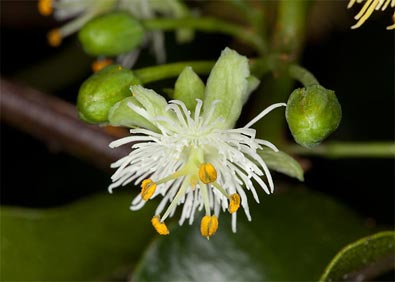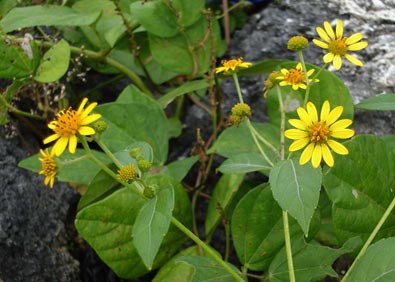| PROTO-POLYNESIAN ETYMOLOGIES |
| Kōhia [Māori] ~ (?) *Kofekofe [? Proto Eastern Polynesian] |
Passiflora tetranda, "NZ Passionfruit " (Passifloraceae). |
|
ALTERNATIVE NAME: Kohekohe
Possibly from
PROTO CENTRAL EASTERN PACIFIC *kofekofe, "Sea daisy", Melanthera biflora (Asteraceae)
through PROTO POLYNESIAN (or Proto Pre-Eastern Polynesian -- see notes below) *kofekofe, Melanthera biflora. |
Proto Central Eastern Pacific (?): *Kofekofe
POSSIBLE REFLEXES IN SOME POLYNESIAN AND OTHER AUSTRONESIAN LANGUAGES:
Fijian: Kovekove (Melanthera biflora, "Sea daisy", Asteraceae)
Tikopian: Kofekofe (Melanthera biflora, "Sea daisy", Asteraceae)
Tuvaluan: Laukofe (Melanthera biflora, "Sea daisy", Asteraceae)
Maori: Kohekohe (Passiflora tetranda, "Kōhia, NZ Passionfruit", Asteraceae)
|

Passiflora tetandra - Kōhia, Akakaikūkū, Pōhuehue
(Hunterville. Photo: (c) Mike Thorsen) |

Passiflora tetandra - Kōhia, with fruit.
(Haywards Hill, Upper Hutt. Photo: "Rudolph89", WikiMedia ) |
|
|
ADDITIONAL ALTERNATIVE MĀORI NAMES
Kāhia; Kaimanu; Kūpapa; Pōhue, Pōhuehue, Pōpōhue; Aka, Akakaikū, Akakaikūkū, Akakōhia, Akakūkū, Akatororaro (Passiflora tetrandra) |
|
RELATED WORDS
Kohe, Kohekohe (Disoxylum spectabile, Meliaceae). |
|
 The name kōhia appears to have originated in Aotearoa. However, the alternative names kohe and kohekohe may possibly be connected with the Tikopian and Fijian words for a the tropical sea daisy, Melanthera biflora, which, like the kōhia (illustrated on the left), has bright yellow flowers (although in the kōhia the yellow is confined to the filaments in the centre of the flowers, and those are sometimes white). This connection is unlikely, but nevertheless opens up interesting possibilities. Since no cognate word is present in Tongan, Samoan and the languages most closely related to them (with the solitary exception of Tuvalu), it is unlikely that a connection with the Fijian word was directly inherited through Proto-Polynesian. There is, however, a remote possibility that the word kofekofe was acquired from Fijian by traders from Tikopia at the time the migrants from "nuclear Polynesia" were in that part of the world, before some of them set off for East Polynesia, and a vague memory of the plant and its name lasted long enough for one of the first settlers of Aotearoa to bestow it on Passiflora tetrandra when its yellow-centred flowers were seen from afar. This is unlikely, but it does make a good story -- see the sections on Proto-Nuclear Polynesian and Proto-Eastern Polynesian in the "Genealogy of Names" page for an outline of the theory linking the Polynesian languages of the Solomon Islands and Micronesian Polynesian Outliers directly with those of Eastern Polynesia. The name kōhia appears to have originated in Aotearoa. However, the alternative names kohe and kohekohe may possibly be connected with the Tikopian and Fijian words for a the tropical sea daisy, Melanthera biflora, which, like the kōhia (illustrated on the left), has bright yellow flowers (although in the kōhia the yellow is confined to the filaments in the centre of the flowers, and those are sometimes white). This connection is unlikely, but nevertheless opens up interesting possibilities. Since no cognate word is present in Tongan, Samoan and the languages most closely related to them (with the solitary exception of Tuvalu), it is unlikely that a connection with the Fijian word was directly inherited through Proto-Polynesian. There is, however, a remote possibility that the word kofekofe was acquired from Fijian by traders from Tikopia at the time the migrants from "nuclear Polynesia" were in that part of the world, before some of them set off for East Polynesia, and a vague memory of the plant and its name lasted long enough for one of the first settlers of Aotearoa to bestow it on Passiflora tetrandra when its yellow-centred flowers were seen from afar. This is unlikely, but it does make a good story -- see the sections on Proto-Nuclear Polynesian and Proto-Eastern Polynesian in the "Genealogy of Names" page for an outline of the theory linking the Polynesian languages of the Solomon Islands and Micronesian Polynesian Outliers directly with those of Eastern Polynesia.
The vine bears orange berries about the size of a cherry or small plum at the tips of stems which may be at the top of a tall tree, so in its natural state it is not an easy fruit for people to harvest, hence the large number of alternative names referring to it as food for certain birds. It was used traditionally however to flavour "certain jellies made from seaweed" (Murdoch Riley, Herbal, p. 213), but the main use was for seeds and pulp as sources of cosmetic and medicinal oil, especially as a body lotion. This could also be used as a salve for wounds that were slow to heal. The flowers are green, enhanced by conspicuous white or yellow filaments at the centre. Like the pua wānanga, the kōhia is a climber frequenting the forest margins.
The dried stems of the kōhia are slow-burning and were and were an excellent way of transporting fire from one location to another. Gum from the cut stems was used as a kind of chewing-gum. Andrew Crowe (Field Guide, p. 39) reports that possums now rival the birds in competing for its fruit. It flowers from October to March, and is found naturally in forests in the North Island and the southern half of the South Island.
Its possible namesake, the Tikopian kofekofe Melanthera biflora, is, along with the tropical pōhue Ipomoea pes-caprae, "usually one of the first species colonizing degraded or altered environments in tropical zones of the planet". It is scrambling plant with woody stems that is found throughout the tropical parts of the Indo-Pacific region, mostly in coastal areas but occasionally inland. Its range includes many Pacific Islands, but it is not listed in the Cook Islands biodiversity database as an indigenous species in the Cook Islands.However it does have an Aituan name, titi tai, and is described in Art Whistler's Ethnobotany of the Cook Islands as "an indigenous shrub, occasional on the shores of Rarotonga, but common on Atiu. The leaves are rubbed onto goggle lenses to prevent fogging". It is laukofe, "kofe plant", in Tuvalu (possibly a later acquistion from Fijian, rather than a directly inherited word), ate in Tonga, and ateate in Samoa. |

Passiflora tetrandra - kōhia, kaimanu, pōhuehue
(Hunterville. Photo: (c) Mike Thorsen, NZPCN) |

Melanthera biflora - Kofekofe (Tikopia)
(On a beach in Tonga. Photo: Tau'olunga, WikiMedia) |
|
| Further information : The works referred to above are listed in the Bibliography, along with other general works on NZ plants. There is also basic information about Passiflora tetrandra, along with some excellent photographs, on the NZPCN web site, and a little more information on the Te Māra Reo page for pōhue. The Australian Tropical Rainforest Plants database has a fact sheet about Melanthera biflora. The quote about its invasive qualities is from the entry for that species in Wikipedia. |
| Photographs: The inset photograph in the text is by (c) Wayne Bennett, NZPCN. Those in the galleries are by NZPCN member Mike Thorsen, and, from WikiMedia, "Rudolph89" and Tau'olunga. Our thanks to all these people for allowing us to use their work. |
|
|

